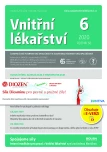Glycated haemoglobin as a marker of elevated LDL and TAG: a cohort study
Authors:
Linda Buková 1; Peter Galajda 2; Martin Javorský 3; Marián Mokáň 2
Authors‘ workplace:
Diabetologická ambulancia Internej kliniky FNsP F. D. Roosevelta, Banská Bystrica, Slovenská republika
1; I. Interná klinika JLF UK a UN Martin, Slovenská republika
2; IV. interná klinika LF UPJŠ a UN L. Pasteura Košice, Slovenská republika
3
Published in:
Vnitř Lék 2020; 66(6): 28-34
Category:
Original Contributions
Overview
Patients with less severe glycated haemoglobin (HbA1c) targets may find it difficult to achieve the target values of lipid parameters treatment at high cardiovascular risk. We have been monitoring the correlation between levels of triglycerides (TG), high density lipoprotein (HDL) and low density lipoprotein (LDL) with glycosylated haemoglobin (HbA1c) by IFCC method (method of testing according to the International Federation of Clinical Chemistry and Laboratory Medicine) and by DCCT method (Diabetes Control and Complication Trial) as well as body mass index (BMI) at the time of diagnosis of the disease, that could help identify patients with an increased risk of cardiovascular disease. In the cohort study we were monitoring outpatients with newly diagnosed type 2 diabetes mellitus during a 5 year period. Patients (117 men, 83 women), aged from 30 to 92 years were conducted sampling blood glucose, HbA1c (IFCC/DCCT), HDL, LDL, TG. At baseline, the patients’ height, weight, waist circumference, calculated BMI and blood pressure were measured. Waist circumference was measured in the horizontal plane in the middle of the distance between the upper edge of the iliac crest and the lower edge of the last rib in the breath. Our study did not exclude patients taking statin or fibrate. The high HbA1c values increased the risk of elevating LDL-cholesterol levels and TAG levels in the whole group (p = 0.012) and (p = 0.017), and the high BMI values increased the risk of lowering HDL-cholesterol levels in the female population (p = 0.010). The results of our study stratify the increased risk of atherogenicity in these groups. HbA1c is a direct marker of elevated LDL and TAG, and indirect marker for coronary artery disease risk assessment.
Keywords:
body mass index – glycated haemoglobin – Lipoproteins – type 2 diabetes mellitus
Sources
1. Vinod Mahato R, Gyawali P, Raut PP, et al. Association between glycaemic control and serum lipid profile in type 2 diabetic patients: glycated haemoglobin as a dual biomarker. Biomed Res 2011; 22 : 375–380.
2. Hussain A, Ali I, Ijaz M, et al. Correlation between hemoglobin A1c and serum lipid profile in Afghani patients with type 2 diabetes: hemoglobin A1c prognosticates dyslipidemia. Ther Adv Endocrinol Metab 2017; 8 : 51–57.
3. Buková L, Galajda P, Mokáň M. Ako dlhšie žiť a pomalšie starnúť. Martin: Vydavateľstvo Quick Print 2018, 150 s.
4. Svačina Š, Műllerová D, Bretšnajdrová A. Dietologie pro lékaře, farmaceuty, zdravotní sestry a nutričné terapeuty. Praha: Vydavateľstvo Triton 2013, 341 s.
5. Pelikánová T Dyslipidemie. In: Pelikánová T, Bartoš V. Praktická diabetologie. Praha: Maxdorf 2018, 310–329.
6. Tkáč I. Je diabetes 2. typu cenou za nízke hladiny LDL cholesterolu? Euni dia special.
7. Vohnout B, Lisičanová J, Havranová A. Inhibítory PCSK9 a diabetes mellitus. Vnitř Lék 2018; 64: 1186–1189.
8. Mokáň jr. M, Galajda P, Mokáň M. Význam glykovaného hemoglobínu ako diagnostického kritéria pri prediabetických stavoch. Diabetes a obezita 2012; 24: 63-68.
9. Naqvi S, Naveed S, Ali Z, et al. Correlation between Glycated Hemoglobin and Triglyceride Level in Type 2 Diabetes Mellitus. Cureus 2017; 9: e1347.
10. Quispe R, Martin SS, Jones SR. Triglycerides to high-density-lipoprotein-cholesterol ratio, glycemic control and cardiovascular risk in obese patients with type 2 diabetes. Curr Opin Endocrinol Diabetes Obes 2016; 23 : 150–156.
11. Ren Y, Luo X, Wang C, et al. Prevalence of hypertriglyceridemic waist and association with risk of type 2 diabetes mellitus: a meta-analysis. Diabetes Metab Res Rev 2016; 32 : 405–412.
12. Tkáč I, Baldaufová L. Rizikový profil a očakávaný prínos farmakologickej liečby u novodiagnostikovaných diabetikov 2. typu. Interná medicína 2005; 9 : 473–477.
13. Klisic A, Kavaric N, Jovanovic M, et al. Association between unfavorable lipid profil and glycemic control in patients with type 2 diabetes mellitus. J Res Med Sci 2017; 22 : 122.
14. ESC/EAS Guidelines for the Management of Dyslipideamias 2016. The Task Force for the Management of Dyslipidaemias of the European Society of Cardiology (ESC) and European Atherosclerosis Society (EAS) Developed with the special contribution of the European Assocciation for Cardiovascular Prevention & Rehabilitation (EACPR). Authors/Task Force Members: Catapano AL, Graham I, De Backer G et al. Atherosclerosis 2016; 253 : 281–344.
15. Žďárská Janíčková D, Kvapil M. Diabetická dyslipidémie In: Moderní diabetologie. Teorie v kasuistikách léčby diabetes mellitus 2. typu. Praha: Current Media 2017, 97–105.
16. Martinka E, Uličiansky V, Mokáň M, et al. Konsenzuálny terapeutický algoritmus pre diabetes mellitus 2. typu (v súlade s SPC, aktuálnym znením indikačných obmedzení a odporúčaní ADA/EASD) Stav k 31. 8. 2016. Interná med 2016; 16 : 301–310.
17. https://www.plantbasednews.org/post/national-institute-plant-based-diet-treat-t2-diabetes
Labels
Diabetology Endocrinology Internal medicineArticle was published in
Internal Medicine

2020 Issue 6
Most read in this issue
- Myocardial infarction or broken heart syndrome?
- Gastrointestinal tract involvement in mixed connective tissue disease (Sharp syndrome)
- Food allergy and intolerance
- Complement deficiencies
